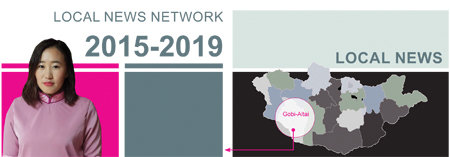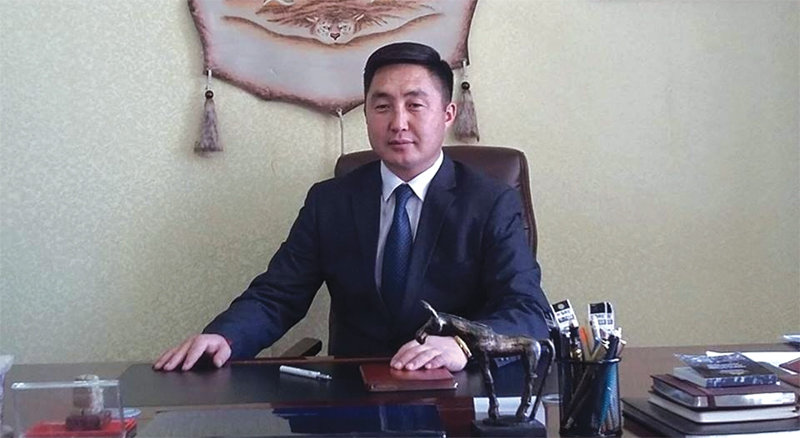
D. Batmagnai, Head of the Environment and Tourism Department in Govi-Altai, talks to A. Nyambayar on how watch is kept on the activities of mining companies in the aimag.

Let me start with a general question. Any mining work has a negative impact on the environment, so do you then think no fresh mining licences, whether exploration or extraction, should be granted?
I think it is right to keep the virgin status of our homeland as much as possible. At the moment, 51 percent of the territory of Govi-Altai aimag is under special protection, not open to mining, and also to preserve our cultural heritage sites. More areas are likely to be kept closed to development of mining. The Government is considering bringing the Khuisiin Gobi and Sutai Khairkhan mountain areas under its special protection. This would be big step in nature conservation. Our laws already prohibit any mining activity in areas near river basins, forests, and water sources.
Now to specifics. How many companies hold exploration and extraction licences in your aimag, and how many of them are actually operating?
According to the Mineral Resources and Petroleum Authority of Mongolia (MRPAM), as of February 28, 2019, there were 115 entities holding 161 mining licences over 870,800 hectares or 6.1 percent of the territory of Govi-Altai. Of these, 50 are for extraction and account for 0.6 percent of the territory. The other 111 are exploration licences over 5.5 percent of the aimag area.
In 2018, five mines worked in Tayannuur, Khov Bulag, Zeegt, Khuurai and Boorog and 52 companies holding 63 licences ran exploration work in 13 soums. At the end of the first quarter this year, Tayannuur iron ore mine, and Zeegt and Khuv Bulag coal mines were active. There are two gold mines which work seasonally, from May to October. Six companies have had their environment management plans registered before starting exploration activities in Erdene, Altai, Tsog and Bugat soums.
Licences have to be renewed every three years. Are there cases of companies keeping on working without extending their licence?
Extension of exploration licenses is made by MRPAM. Exploration activities can begin only after an activities plan is approved. All companies planning to conduct geological prospecting and exploration have to be registered annually with the aimag’s Environment and Tourism Department.
At the time of such registration, we check if the licence is valid or not, so there is no company operating without renewing its licence.
How do you oversee the companies’ activities? Do you face problems?
Actually, our responsibility goes beyond mining and covers activities of companies in any type of manufacturing or offering any service using natural resources. Our guidelines are set out in the various laws and resolutions on nature and the environment, and by the environmental impact assessments of individual companies. We monitor implementation of the environment management plans of licence-holder companies. Another very important area of our work is to check how the laws on water use and waste disposal are observed. We face no problem as such in our inspection activities, and we always advise companies to strictly follow their environmental management plan by spending the necessary money, and also to make sure they pay their dues to all authorities.
Do mining companies comply with regulations and standards in their reclamation activities?
In our aimag, Altain Khuder, NCGT, Tsogts Erin Trans, Gobi Coal and Energy, and the Mandal Altai Group do extraction work at five mines: Tayannuur iron ore deposit, Khuurai, Boorog placer gold, and at Zeegt and Khuv Bulag coal mine. Their combined operations affect a total of 114.78 hectares. In 2018, Tsogt Erin Trans did technical reclamation on 19.23 hectares, but the other four have no reclamation plans as yet as they will be operating for several years more.
What penalty is imposed on companies that fail to do reclamation?
Reclamation has not been done on 7.4 hectares at Maanit mine where Mandal Altai Group operated between 2005 and 2010. The term of its mining licence has not yet expired, so we and the other concerned organizations are watching and reviewing the case. The usual practice in these cases is to serve a notice on the company reminding it of the legal obligation to take up reclamation if it does not intend to resume mining in the years remaining of the licence.
In cases where environmental reclamation is not done, the licence held by the company is revoked by the central administrative organization, on receipt of a report by the local administrative organisation. The company will also be charged under Article 66 of the Minerals Law, and the Criminal Code, and/or the Law on Violations. The damage done will be assessed by a specialized organization, and the company has to pay for an authorized organization to do the reclamation.
What about reclamation of areas where artisanal miners worked? How are their activities supervised and how are they made to cooperate?
We do some work based on police reports. As for cooperation, every year, we and the Department of Investment and Development Policy Planning of the Governor’s Office jointly organise an artisanal miners’ forum that is attended by heads of soums, environmental inspectors, heads of bags, representatives of artisanal miners’ cooperatives and non-governmental organizations. The forum comes up with some recommendations on ways to resolve urgent problems, to extend cooperation and to conduct reclamation. In addition, we encourage illegal miners to join the artisanal mining structure and to participate in regional, aimag and soum level seminars, trainings and experience-sharing meetings, and provide them with books and manuals to help them act within the legal framework
Apart from nine non-governmental organizations looking after their interests, the aimag has one central association and 24 registered and non-registered cooperatives of artisanal miners, and 284 registered individual miners. Between 2014 and 2018, reclamation was carried out on 91.15 hectares with funds from the local community budget.
One of your largest miners, Altain Khuder, is blamed for creating too much dust. What are the steps you have taken in this regard?
Altain Khuder runs the Tayannuur mine and its environmental management plan has been approved by the Ministry of Environment and Tourism. It submits a performance report every year. A team established under orders of the aimag Governor inspects the situation on the ground and its conclusions are submitted to the ministry, which then takes a decision.
Various steps were taken from time to time to tackle the issue of dust. Water is sprayed in the mine zone and on the haul road, and a paved road has been built in the mine area. Vacuum cleaners have been installed in some areas of the plant. However, things have not improved much. It was clear that the most important thing was to pave the haul road and the company was asked to do this. So far 86.8 km of the 168.3-km road from the mine site to the Burgastai border has been paved, and things are better. We all hope the problem will become negligible when the entire road is paved.
Which issues appear most troublesome to you and how will you deal with them?
It is essential that companies fulfil their legal obligations in a responsible manner. That can, and is, ensured by aimag and soum organizations making regular inspections, rendering support by giving proper advice and offering cooperation. The more difficult issues arise when illegal operators use sophisticated equipment for mining in a prohibited area in the name of reclamation. There is no legal provision allowing extraction in the name of reclamation, and no local authority can be a party to such activity. Also some artisanal mining is carried on in areas where the law allows extraction only after certain issues are resolved. This is totally illegal and we have to take preventive measures and then conduct inspections regularly.